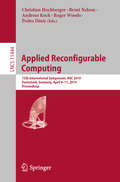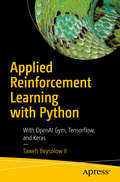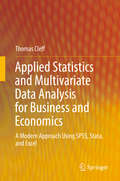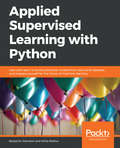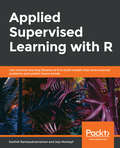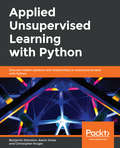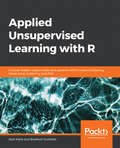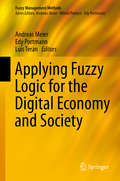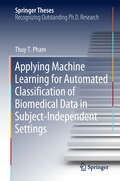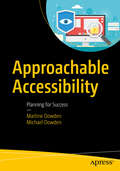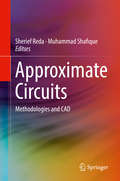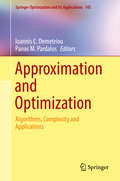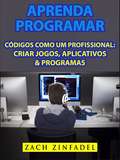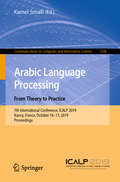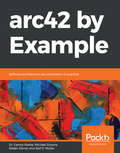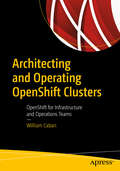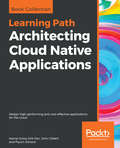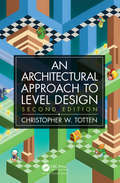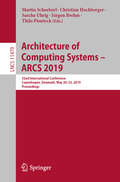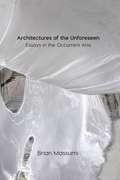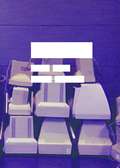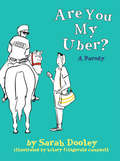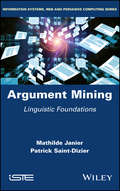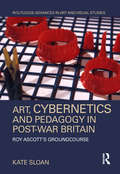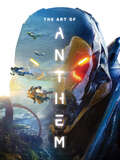- Table View
- List View
Applied Reconfigurable Computing: 15th International Symposium, ARC 2019, Darmstadt, Germany, April 9–11, 2019, Proceedings (Lecture Notes in Computer Science #11444)
by Roger Woods Christian Hochberger Brent Nelson Andreas Koch Pedro DinizThis book constitutes the proceedings of the 15th International Symposium on Applied Reconfigurable Computing, ARC 2019, held in Darmstadt, Germany, in April 2019. The 20 full papers and 7 short papers presented in this volume were carefully reviewed and selected from 52 submissions. In addition, the volume contains 1 invited paper. The papers were organized in topical sections named: Applications; partial reconfiguration and security; image/video processing; high-level synthesis; CGRAs and vector processing; architectures; design frameworks and methodology; convolutional neural networks.
Applied Reinforcement Learning with Python: With OpenAI Gym, Tensorflow, and Keras
by Taweh Beysolow IIDelve into the world of reinforcement learning algorithms and apply them to different use-cases via Python. This book covers important topics such as policy gradients and Q learning, and utilizes frameworks such as Tensorflow, Keras, and OpenAI Gym. Applied Reinforcement Learning with Python introduces you to the theory behind reinforcement learning (RL) algorithms and the code that will be used to implement them. You will take a guided tour through features of OpenAI Gym, from utilizing standard libraries to creating your own environments, then discover how to frame reinforcement learning problems so you can research, develop, and deploy RL-based solutions. What You'll LearnImplement reinforcement learning with Python Work with AI frameworks such as OpenAI Gym, Tensorflow, and KerasDeploy and train reinforcement learning–based solutions via cloud resourcesApply practical applications of reinforcement learning Who This Book Is For Data scientists, machine learning engineers and software engineers familiar with machine learning and deep learning concepts.
Applied Statistics and Multivariate Data Analysis for Business and Economics: A Modern Approach Using SPSS, Stata, and Excel
by Thomas CleffThis textbook will familiarize students in economics and business, as well as practitioners, with the basic principles, techniques, and applications of applied statistics, statistical testing, and multivariate data analysis. Drawing on practical examples from the business world, it demonstrates the methods of univariate, bivariate, and multivariate statistical analysis. The textbook covers a range of topics, from data collection and scaling to the presentation and simple univariate analysis of quantitative data, while also providing advanced analytical procedures for assessing multivariate relationships. Accordingly, it addresses all topics typically covered in university courses on statistics and advanced applied data analysis. In addition, it does not limit itself to presenting applied methods, but also discusses the related use of Excel, SPSS, and Stata.
Applied Supervised Learning with Python: Use scikit-learn to build predictive models from real-world datasets and prepare yourself for the future of machine learning
by Benjamin Johnston Ishita MathurExplore the exciting world of machine learning with the fastest growing technology in the worldKey FeaturesUnderstand various machine learning concepts with real-world examplesImplement a supervised machine learning pipeline from data ingestion to validationGain insights into how you can use machine learning in everyday lifeBook DescriptionMachine learning—the ability of a machine to give right answers based on input data—has revolutionized the way we do business. Applied Supervised Learning with Python provides a rich understanding of how you can apply machine learning techniques in your data science projects using Python. You'll explore Jupyter Notebooks, the technology used commonly in academic and commercial circles with in-line code running support.With the help of fun examples, you'll gain experience working on the Python machine learning toolkit—from performing basic data cleaning and processing to working with a range of regression and classification algorithms. Once you’ve grasped the basics, you'll learn how to build and train your own models using advanced techniques such as decision trees, ensemble modeling, validation, and error metrics. You'll also learn data visualization techniques using powerful Python libraries such as Matplotlib and Seaborn. This book also covers ensemble modeling and random forest classifiers along with other methods for combining results from multiple models, and concludes by delving into cross-validation to test your algorithm and check how well the model works on unseen data.By the end of this book, you'll be equipped to not only work with machine learning algorithms, but also be able to create some of your own!What you will learnUnderstand the concept of supervised learning and its applicationsImplement common supervised learning algorithms using machine learning Python librariesValidate models using the k-fold techniqueBuild your models with decision trees to get results effortlesslyUse ensemble modeling techniques to improve the performance of your modelApply a variety of metrics to compare machine learning modelsWho this book is forApplied Supervised Learning with Python is for you if you want to gain a solid understanding of machine learning using Python. It'll help if you to have some experience in any functional or object-oriented language and a basic understanding of Python libraries and expressions, such as arrays and dictionaries.
Applied Supervised Learning with R: Use machine learning libraries of R to build models that solve business problems and predict future trends
by Jojo Moolayil Karthik RamasubramanianExplore supervised machine learning with R by studying popular real-world uses cases such as object detection in driverless cars, customer churn, and default predictionKey FeaturesStudy supervised learning algorithms by using real-world datasets Fine tune optimal parameters with hyperparameter optimizationSelect the best algorithm using the model evaluation frameworkBook DescriptionR provides excellent visualization features that are essential for exploring data before using it in automated learning. Applied Supervised Learning with R helps you cover the complete process of employing R to develop applications using supervised machine learning algorithms for your business needs. The book starts by helping you develop your analytical thinking to create a problem statement using business inputs and domain research. You will then learn different evaluation metrics that compare various algorithms, and later progress to using these metrics to select the best algorithm for your problem. After finalizing the algorithm you want to use, you will study the hyperparameter optimization technique to fine-tune your set of optimal parameters. To prevent you from overfitting your model, a dedicated section will even demonstrate how you can add various regularization terms.By the end of this book, you will have the advanced skills you need for modeling a supervised machine learning algorithm that precisely fulfills your business needs.What you will learnDevelop analytical thinking to precisely identify a business problemWrangle data with dplyr, tidyr, and reshape2Visualize data with ggplot2Validate your supervised machine learning model using k-fold Optimize hyperparameters with grid and random search, and Bayesian optimizationDeploy your model on Amazon Web Services (AWS) Lambda with plumberImprove your model’s performance with feature selection and dimensionality reductionWho this book is forThis book is specially designed for novice and intermediate-level data analysts, data scientists, and data engineers who want to explore different methods of supervised machine learning and its various use cases. Some background in statistics, probability, calculus, linear algebra, and programming will help you thoroughly understand and follow the content of this book.
Applied Unsupervised Learning with Python: Discover hidden patterns and relationships in unstructured data with Python
by Benjamin Johnston Aaron Jones Christopher KrugerDesign clever algorithms that can uncover interesting structures and hidden relationships in unstructured, unlabeled dataKey FeaturesLearn how to select the most suitable Python library to solve your problemCompare k-Nearest Neighbor (k-NN) and non-parametric methods and decide when to use themDelve into the applications of neural networks using real-world datasetsBook DescriptionUnsupervised learning is a useful and practical solution in situations where labeled data is not available. Applied Unsupervised Learning with Python guides you on the best practices for using unsupervised learning techniques in tandem with Python libraries and extracting meaningful information from unstructured data. The course begins by explaining how basic clustering works to find similar data points in a set. Once you are well versed with the k-means algorithm and how it operates, you’ll learn what dimensionality reduction is and where to apply it. As you progress, you’ll learn various neural network techniques and how they can improve your model. While studying the applications of unsupervised learning, you will also understand how to mine topics that are trending on Twitter and Facebook and build a news recommendation engine for users. You will complete the course by challenging yourself through various interesting activities such as performing a Market Basket Analysis and identifying relationships between different merchandises. By the end of this course, you will have the skills you need to confidently build your own models using Python.What you will learnUnderstand the basics and importance of clusteringBuild k-means, hierarchical, and DBSCAN clustering algorithms from scratch with built-in packagesExplore dimensionality reduction and its applicationsUse scikit-learn (sklearn) to implement and analyse principal component analysis (PCA)on the Iris datasetEmploy Keras to build autoencoder models for the CIFAR-10 datasetApply the Apriori algorithm with machine learning extensions (Mlxtend) to study transaction dataWho this book is forThis course is designed for developers, data scientists, and machine learning enthusiasts who are interested in unsupervised learning. Some familiarity with Python programming along with basic knowledge of mathematical concepts including exponents, square roots, means, and medians will be beneficial.
Applied Unsupervised Learning with R
by Bradford TuckfieldApplied Unsupervised Learning with R is designed for business professionals, who want to learn about methods to understand their data better, and developers, who have an interest in unsupervised learning. It'll help you to have basic, beginner-level familiarity with R, including how to open the R console, how to read data, and how to create a loop. To easily understand the concepts of this book, you should know basic mathematical concepts, such as exponents, square roots, means, and medians.
Applying Fuzzy Logic for the Digital Economy and Society (Fuzzy Management Methods)
by Andreas Meier Edy Portmann Luis TeránThis edited book presents the state-of-the-art of applying fuzzy logic to managerial decision-making processes in areas such as fuzzy-based portfolio management, recommender systems, performance assessment and risk analysis, among others. Presenting the latest research, with a strong focus on applications and case studies, it is a valuable resource for researchers, practitioners, project leaders and managers wanting to apply or improve their fuzzy-based skills.
Applying Machine Learning for Automated Classification of Biomedical Data in Subject-Independent Settings (Springer Theses)
by Thuy T. PhamThis book describes efforts to improve subject-independent automated classification techniques using a better feature extraction method and a more efficient model of classification. It evaluates three popular saliency criteria for feature selection, showing that they share common limitations, including time-consuming and subjective manual de-facto standard practice, and that existing automated efforts have been predominantly used for subject dependent setting. It then proposes a novel approach for anomaly detection, demonstrating its effectiveness and accuracy for automated classification of biomedical data, and arguing its applicability to a wider range of unsupervised machine learning applications in subject-independent settings.
Approachable Accessibility: Planning for Success
by Martine Dowden Michael DowdenUnderstand the realities of modern web accessibility and what considerations should be made to include everyone. There are hundreds of millions of people who are being left out every single day on the web due to disability or circumstance. The purpose of web accessibility is to remove barriers and bring the information, services, and functionality of the web to as many people as possible so they can be included in this global community. This book makes the topic of web accessibility as approachable as possible to help every web professional become an accessibility advocate at their companies, on their projects, and in their communities. This discussion will go beyond the buzzword to explore the impact our designs and decisions have on real people, along with the ethical, legal, and financial incentives for accessibility prioritization. For those who are ready to get started the book covers tools and techniques for testing websites or web applications for conformance to the Web Content Accessibility Guidelines. Because we very rarely work in a vacuum the book also covers how to educate your team or company management on web accessibility as well as persuading them to invest time and money in accessibility. For those looking to start an accessibility practice at their company – or simply to ensure that nothing slips through the cracks – the book includes a guide to creating your very own accessibility action plan. Having a well-documented plan of action is an essential step in the long-term success of any initiative. Get started with web accessibility using Approachable Accessibility today. What You'll LearnDiscover various ways that website design can exclude or even harm usersGain an understanding of the Web Content Accessibility Guidelines (WCAG) 2.1Put together an accessibility action plan for your organizationExplore tools and techniques for evaluating your existing websites Who This Book Is For Web designers and developers who want to know more about web accessibility or just want to know how to get started; tech leaders who need help building an accessibility practice or convincing their company to invest in web accessibility; project managers and owners making scope decisions for a project.
Approximate Circuits: Methodologies and CAD
by Sherief Reda Muhammad ShafiqueThis book provides readers with a comprehensive, state-of-the-art overview of approximate computing, enabling the design trade-off of accuracy for achieving better power/performance efficiencies, through the simplification of underlying computing resources. The authors describe in detail various efforts to generate approximate hardware systems, while still providing an overview of support techniques at other computing layers. The book is organized by techniques for various hardware components, from basic building blocks to general circuits and systems.
Approximation and Optimization: Algorithms, Complexity and Applications (Springer Optimization and Its Applications #145)
by Ioannis C. Demetriou Panos M. PardalosThis book focuses on the development of approximation-related algorithms and their relevant applications. Individual contributions are written by leading experts and reflect emerging directions and connections in data approximation and optimization. Chapters discuss state of the art topics with highly relevant applications throughout science, engineering, technology and social sciences. Academics, researchers, data science practitioners, business analysts, social sciences investigators and graduate students will find the number of illustrations, applications, and examples provided useful. This volume is based on the conference Approximation and Optimization: Algorithms, Complexity, and Applications, which was held in the National and Kapodistrian University of Athens, Greece, June 29–30, 2017. The mix of survey and research content includes topics in approximations to discrete noisy data; binary sequences; design of networks and energy systems; fuzzy control; large scale optimization; noisy data; data-dependent approximation; networked control systems; machine learning ; optimal design; no free lunch theorem; non-linearly constrained optimization; spectroscopy.
Aprenda programar códigos como um Profissional: Criar jogos, Aplicativos & Programas
by Zach ZinfadelAprenda programar códigos como um Profissional: Criar jogos, Aplicativos & Programas por Zach Zinfadel Com este livro você não aprende só programação, mas também aborda tópicos que as aulas e outros livros não ensinam. Fornece também instruções específicas e fáceis de seguir, passos de como criar códigos de forma correta. Itens inclusos: - Tutoriais de programação em HTML e JavaScript. - Introdução à programação e códigos. - O que são variáveis e como usá-las. - Tudo sobre arrays e declarações lógicas. - Tudo sobre funções e como elas funcionam. - Como criar seu primeiro programa. >>> Clique acima para comprar instantaneamente! Gênero: COMPUTADORES / Programação / Geral Gênero Secundário: COMPUTADORES / Programação Web / Web Língua: Português BR
Arabic Language Processing: 7th International Conference, ICALP 2019, Nancy, France, October 16–17, 2019, Proceedings (Communications in Computer and Information Science #1108)
by Kamel SmaïliThis book constitutes revised selected papers from the 7th International Conference on Arabic Language Processing, ICALP 2019, held in Nancy, France, in October 2019. The 21 full papers presented in this volume were carefully reviewed and selected from 38 submissions. They were organized in topical sections named: Arabic dialects and sentiment analysis; neural techniques for text and speech; modeling modern standard Arabic; resources: analysis, disambiguation and evaluation.
arc42 by Example: Software architecture documentation in practice
by Dr. Gernot Starke Michael Simons Stefan Zorner Ralf D. MullerDocument the architecture of your software easily with this highly practical, open-source template. Key Features Get to grips with leveraging the features of arc42 to create insightful documents Learn the concepts of software architecture documentation through real-world examples Discover techniques to create compact, helpful, and easy-to-read documentation Book Description When developers document the architecture of their systems, they often invent their own specific ways of articulating structures, designs, concepts, and decisions. What they need is a template that enables simple and efficient software architecture documentation. arc42 by Example shows how it's done through several real-world examples. Each example in the book, whether it is a chess engine, a huge CRM system, or a cool web system, starts with a brief description of the problem domain and the quality requirements. Then, you'll discover the system context with all the external interfaces. You'll dive into an overview of the solution strategy to implement the building blocks and runtime scenarios. The later chapters also explain various cross-cutting concerns and how they affect other aspects of a program. What you will learn Utilize arc42 to document a system's physical infrastructure Learn how to identify a system's scope and boundaries Break a system down into building blocks and illustrate the relationships between them Discover how to describe the runtime behavior of a system Know how to document design decisions and their reasons Explore the risks and technical debt of your system Who this book is for This book is for software developers and solutions architects who are looking for an easy, open-source tool to document their systems. It is a useful reference for those who are already using arc42. If you are new to arc42, this book is a great learning resource. For those of you who want to write better technical documentation will benefit from the general concepts covered in this book.
Architecting and Operating OpenShift Clusters: OpenShift for Infrastructure and Operations Teams
by William CabanDesign and architect resilient OpenShift clusters and gain a keen understanding of how hundreds of projects are integrated into a powerful solution. While there are many OpenShift resources available for developers, this book focuses on the key elements of infrastructure and operations that teams need when looking to integrate and maintain this platform. You'll review important concepts, such as repeatable deployment techniques, advanced OpenShift RBAC capabilities, monitoring clusters, and integrating with external services. You'll also see how to run specialized workloads in OpenShift and how to deploy non-web based applications on the platform, all designed to help cultivate best practices as your organization continue evolve in microservices architectures. OpenShift has become the main enterprise Kubernetes distribution and its market penetration continues to growth at rapid rate. While OpenShift’s documentation provides a great list of configuration options to work with the platform, it can be a daunting task to wade through. Architecting and Operating OpenShift Clusters breaks this content down into clear and useful concepts to provide you with a solid understanding of the OpenShift internal architecture. What You'll Learn Operate high availability in muti-tenant OCP clusters Understand OpenShift SDN models, capabilities, and storage classes Integrate OCP with existing data center capabilities and CI/CD pipelines Support advanced capabilities like: Istio, Multus, Kubernetes Operators, hybrid deployments Who This Book Is For Cloud architects, OpenShift cluster administrators, and teams supporting developers in OpenShift environments who have a basic understanding of this platform and microservices architectures.
Architecting Cloud Native Applications: Design high-performing and cost-effective applications for the cloud
by Kamal Arora Erik Farr John Gilbert Piyum ZonoozApply cloud native patterns and practices to deliver responsive, resilient, elastic, and message-driven systems with confidence Key Features Discover best practices for applying cloud native patterns to your cloud applications Explore ways to effectively plan resources and technology stacks for high security and fault tolerance Gain insight into core architectural principles using real-world examples Book Description Cloud computing has proven to be the most revolutionary IT development since virtualization. Cloud native architectures give you the benefit of more flexibility over legacy systems. This Learning Path teaches you everything you need to know for designing industry-grade cloud applications and efficiently migrating your business to the cloud. It begins by exploring the basic patterns that turn your database inside out to achieve massive scalability. You'll learn how to develop cloud native architectures using microservices and serverless computing as your design principles. Then, you'll explore ways to continuously deliver production code by implementing continuous observability in production. In the concluding chapters, you'll learn about various public cloud architectures ranging from AWS and Azure to the Google Cloud Platform, and understand the future trends and expectations of cloud providers. By the end of this Learning Path, you'll have learned the techniques to adopt cloud native architectures that meet your business requirements. This Learning Path includes content from the following Packt products: Cloud Native Development Patterns and Best Practices by John Gilbert Cloud Native Architectures by Erik Farr et al. What you will learn Understand the difference between cloud native and traditional architecture Automate security controls and configuration management Minimize risk by evolving your monolithic systems into cloud native applications Explore the aspects of migration, when and why to use it Apply modern delivery and testing methods to continuously deliver production code Enable massive scaling by turning your database inside out Who this book is for This Learning Path is designed for developers who want to progress into building cloud native systems and are keen to learn the patterns involved. Software architects, who are keen on designing scalable and highly available cloud native applications, will also find this Learning Path very useful. To easily grasp these concepts, you will need basic knowledge of programming and cloud computing.
Architectural Approach to Level Design: Second edition
by Christopher TottenWritten by a game developer and professor trained in architecture, An Architectural Approach to Level Design is one of the first books to integrate architectural and spatial design theory with the field of level design. It explores the principles of level design through the context and history of architecture. Now in its second edition, An Architectural Approach to Level Design presents architectural techniques and theories for you to use in your own work. The author connects architecture and level design in different ways that address the practical elements of how designers construct space and the experiential elements of how and why humans interact with that space. It also addresses industry issues like how to build interesting tutorial levels and how to use computer-generated level design systems without losing the player-focused design of handmade levels. Throughout the text, you will learn skills for spatial layout, evoking emotion through gamespaces, and creating better levels through architectural theory. FEATURES Presents case studies that offer insight on modern level design practices, methods, and tools Presents perspectives from industry designers, independent game developers, scientists, psychologists, and academics Explores how historical structures can teach us about good level design Shows how to use space to guide or elicit emotion from players Includes chapter exercises that encourage you to use principles from the chapter in digital prototypes, playtesting sessions, paper mock-ups, and design journals Bringing together topics in game design and architecture, this book helps you create better spaces for your games. Software independent, the book discusses tools and techniques that you can use in crafting your interactive worlds.
Architecture of Computing Systems – ARCS 2019: 32nd International Conference, Copenhagen, Denmark, May 20–23, 2019, Proceedings (Lecture Notes in Computer Science #11479)
by Martin Schoeberl Christian Hochberger Sascha Uhrig Jürgen Brehm Thilo PionteckThis book constitutes the proceedings of the 32nd International Conference on Architecture of Computing Systems, ARCS 2019, held in Copenhagen, Denmark, in May 2019. The 24 full papers presented in this volume were carefully reviewed and selected from 40 submissions. ARCS has always been a conference attracting leading-edge research outcomes in Computer Architecture and Operating Systems, including a wide spectrum of topics ranging from embedded and real-time systems all the way to large-scale and parallel systems. The selected papers are organized in the following topical sections: Dependable systems; real-time systems; special applications; architecture; memory hierarchy; FPGA; energy awareness; NoC/SoC. The chapter 'MEMPower: Data-Aware GPU Memory Power Model' is open access under a CC BY 4.0 license at link.springer.com.
Architectures of the Unforeseen: Essays in the Occurrent Arts
by Brian MassumiA beautifully written study of three pioneering artists, entwining their work and our understanding of creativity Bringing the creative process of three contemporary artists into conversation, Architectures of the Unforeseen stages an encounter between philosophy and art and design. Its gorgeous prose invites the reader to think along with Brian Massumi as he thoroughly embodies the work of these artists, walking the line that separates theory from art and providing equally nurturing sustenance for practicing artists and working philosophers.Based on Massumi’s lengthy—and in two cases decades-long—relationships with digital architect Greg Lynn, interactive media artist Rafael-Lozano Hemmer, and mixed-media installation creator Simryn Gill, Architectures of the Unforeseen delves into their processes of creating art. The book’s primary interest is in what motivates each artist’s practice—the generative knots that inspire creativity—and in how their pieces work to give off their unique effects. More than a series of profiles or critical pieces, Massumi’s essays are creative, developing new philosophical concepts and offering rigorous sentiments about art and creativity.Asking fundamental questions about nature, culture, and the emergence of the new, Architectures of the Unforeseen is important original research on artists that are pioneers in their field. Equally valuable to the everyday reader and those engaged in scholarly work, it is destined to become an important book not only for the fields of digital architecture, interactive media, and installation art, but also more basically for our knowledge of art and creativity.
Archives
by Andrew Lison Marcel Mars Tomislav Medak Rick PrelingerHow digital networks and services bring the issues of archives out of the realm of institutions and into the lives of everyday users Archives have become a nexus in the wake of the digital turn. Electronic files, search engines, video sites, and media player libraries make the concepts of “archival” and “retrieval” practically synonymous with the experience of interconnected computing. Archives today are the center of much attention but few agendas. Can archives inform the redistribution of power and resources when the concept of the public library as an institution makes knowledge and culture accessible to all members of society regardless of social or economic status? This book sets out to show that archives need our active support and continuing engagement. This volume offers three distinct perspectives on the present status of archives that are at once in disagreement and solidarity with each other, from contributors whose backgrounds cut across the theory–practice divide. Is the increasing digital storage of knowledge pushing us toward a turning point in its democratization? Can archives fulfill their paradoxical potential as utopian sites in which the analog and the digital, the past and future, and remembrance and forgetting commingle? Is there a downside to the present-day impulse toward total preservation?
Are You My Uber?: A Parody
by Sarah Amelia DooleyWe've all been there. You call an Uber. The app says it has arrived, but . . . where is it? Where is your Uber?Are You My Uber? is a 21st Century parody of the 1960 P.D. Eastman children's book Are You My Mother? A man steps off the midnight bus at Port Authority. His name? Unknown. His goal? To find his Uber, an elusive Ford Taurus. Lost and alone in a new city, he steels himself and begins by passing right by the very object of his search. Hilarity ensues: the man proceeds to knock at the doors of an off-duty cab, a helicopter, a halal cart, and other vehicles increasing in their absurdity, willing to try anything to find his Uber.Paired with illustrations by Hilary Fitzgerald Campbell, co-illustrator of Feminist Fight Club, Sarah Dooley's hilarious imagined story is as ridiculous as it is relatable.
Argument Mining: Linguistic Foundations
by Mathilde Janier Patrick Saint-DizierThis book is an introduction to the linguistic concepts of argumentation relevant for argument mining, an important research and development activity which can be viewed as a highly complex form of information retrieval, requiring high-level natural language processing technology. While the first four chapters develop the linguistic and conceptual aspects of argument expression, the last four are devoted to their application to argument mining. These chapters investigate the facets of argument annotation, as well as argument mining system architectures and evaluation. How annotations may be used to develop linguistic data and how to train learning algorithms is outlined. A simple implementation is then proposed. The book ends with an analysis of non-verbal argumentative discourse. Argument Mining is an introductory book for engineers or students of linguistics, artificial intelligence and natural language processing. Most, if not all, the concepts of argumentation crucial for argument mining are carefully introduced and illustrated in a simple manner.
Art, Cybernetics and Pedagogy in Post-War Britain: Roy Ascott’s Groundcourse (Routledge Advances in Art and Visual Studies)
by Kate SloanThis is the first full-length study about the British artist Roy Ascott, one of the first cybernetic artists, with a career spanning seven decades to date. The book focuses on his early career, exploring the evolution of his early interests in communication in the context of the rich overlaps between art, science and engineering in Britain during the 1950s and 1960s. The first part of the book looks at Ascott’s training and early work. The second park looks solely at Groundcourse, Ascott’s extraordinary pedagogical model for visual arts and cybernetics which used an integrative and systems-based model, drawing in behaviourism, analogue machines, performance and games. Using hitherto unpublished photographs and documents, this book will establish a more prominent place for cybernetics in post-war British art.
The Art of Anthem
by Derek Watts Jonathan Warner Steve Kilt Ken FaircloughHundreds of pieces of art with commentary detailing the creation of BioWare's groundbreaking epic in an expertly designed hardcover volume!From the studio behind the hit franchises Dragon Age and Mass Effect comes the thrilling world of Anthem. Dark Horse Books and BioWare are proud to present The Art of Anthem, showcasing the grandeur and beauty of this dangerous new world.Filled with behind-the-scenes looks at four years of game production, original concept art, and exclusive commentary from developers, The Art of Anthem is a fantastic addition to any gamer fan's bookshelf!
